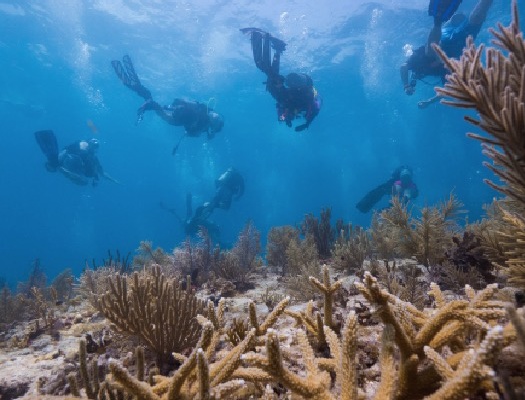
Feature
Oceans of Opportunity
Mote Research is Changing the World
Even in an area known for its munificent philanthropy, it was a gasp-worthy moment when Mote Marine Laboratory announced in January 2015 that it aimed to raise $50 million to achieve its 2020 Vision and Strategic Plan. The Plan aims to increase Mote’s ability to conduct world-class marine research, recruit and nurture the next generation of marine scientists, continue and enhance Mote’s public service to its communities, and transfer and translate its science and technology for the betterment of society and the environment.
Considering that Oceans of Opportunity is Mote’s first multi-year comprehensive fundraising campaign, it is even more impressive that the independent marine research and education institution sailed past that goal in considerably less than two years. That success may be particularly eye opening for those who have not peeked beyond Mote’s public-facing aquarium to learn that it is so much more than a wonderful way to spend an afternoon.
As important a role as the aquarium plays in nurturing appreciation for the wonders of the seas and the extraordinary creatures that inhabit it, Mote’s marine scientists also are responsible for world-changing breakthroughs in coral restoration and aquaculture. They are exploring potential breakthroughs to help mankind find new sources of marine-based, potentially life-saving drugs, seeking ways to save fisheries, working to educate the rest of us about the importance of conservation and much more. While Mote has announced that the campaign has exceeded its $50 million goal, funds are continuing to be raised, and Dr. Michael P. Crosby, Mote’s President and CEO, will reveal the exact amount on October 29 at the Oceanic Evening gala at The Ritz–Carlton, Sarasota.
“People do not expect world-class science in Sarasota, but Mote has it. Very few people can’t find something about Mote that excites them. Scuba divers and snorkelers care about saving the coral reefs or if someone cares about human health and medicine, they can find that,” says Bob Essner, Mote trustee and Chairman of the Oceans of Opportunity campaign. “The aquarium is a great thing, it is the public outreach arm of Mote’s research, but some people may not realize just how much research is being done behind those aquarium walls. Maybe the most important legacy of the campaign, in addition to raising the money to support Mote’s 2020 plan, is that we now have a large number of people who know that Mote is a strong marine laboratory with many compelling projects. That is a lasting legacy of the campaign.”
Another key factor in the campaign’s success is its grounding in the 2020 Vision and Strategic Plan that Crosby was responsible for initiating when he joined Mote in 2010. “Mote has done an outstanding job of laying out its future and envisioning what it wants to be, and the campaign was based on what financial resources would make it real,” Essner says. “That is compelling when asking donors to help.”
Philanthropic support has been one of Mote’s cornerstones from the very beginning, and the vital role it plays can be seen in the game-changing technological breakthrough that can eliminate the dire prospects faced by the world’s coral reefs until very recently. The breakthrough came from what the New York Times called a “eureka mistake” by Dr. David Vaughan, Executive Director of the Mote Tropical Research Lab on Summerland Key. “This wasn’t developed with funding through normal government grants because it’s pretty audacious,” Crosby says. “Dr. Vaughan had the eureka moment and revealed a new technology that pushed the frontiers of science and changed the whole paradigm for coral restoration. Now, we will be able to restore the coral reefs in our lifetimes. Philanthropy helped fill that funding gap and made an enormous impact in moving it forward.”
Coral reefs account for less than 1 percent of the ocean floor, but support more species per unit area than any other marine environment. Loss of the reefs would lead to loss of enormous biodiversity and the collapse of much of the world’s fisheries that rely on them for breeding grounds and nurseries, food, and shelter from predators. For those driven by the bottom line, tourism related to the reefs brings $7.6 billion to Florida’s coffers, and the reefs’ role in protecting shoreline during storms and hurricanes affects us all. “Most people think reefs are just pretty things to look at,” Vaughan says. “If we lose the coral reefs, we’ll lose the places we love to live.”
And losing the reefs, which grow at a snail’s pace spanning decades, seemed virtually inevitable only a few years ago. Climate change has raised the temperature of the world’s oceans and increased carbon dioxide in the atmosphere. The increased carbon dioxide is absorbed into the waters, boosting acidity levels. These challenges, combined with coral disease and other threats, have resulted in the loss of 25 to 40 percent of the world’s corals with the prospect of losing the remaining coral in the next 100 years. That is, until Vaughan’s fortuitous accident. While he was moving a coral that had taken three years to grow from an egg into a 50 cent size piece, it broke, and Vaughan noticed that it had already grown back within a couple of weeks.
Now, using a micro-fragmentation and re-skinning process, coral is broken into tiny pieces that allow it to grow 25 to 40 times faster, meaning that in nine months, those pieces can grow to the size of a coral that would take 15 to 25 years to achieve in the wild. The large, reef-building varieties, such as brain, boulder, star and mounding corals, can be grown in one to three years instead of hundreds needed for natural recovery. Given the increasing impacts of climate change over time, Mote marine scientists also are exploring which species of coral are likely to survive best in increasingly hotter and more acidic ocean waters in the future.
Oceans of Opportunity funding is replacing a deteriorating 45-year-old building on Summerland Key with a larger LEED-certified research facility that will double the amount of laboratory space and will include classrooms for greater numbers of visiting students and other scientists from around the globe who want to replicate Mote’s process and restore the reefs in their countries’ waters. “If you asked me five years ago where we would be in coral restoration, I never would have foreseen where we are today. I hope five years from now, we take coral restoration as much for granted as we do replanting forests or dune grass,” Vaughan says. “I predict we will plant over one million corals in the next several years, and we might be able to take many off the endangered species list.”
In order to ensure Mote’s ability to continue its ground-breaking research by nurturing the next generation of marine scientists, Oceans of Opportunity also is helping support a new two-year postdoctoral research fellowship program and its three-year Eminent Scholar program. “Bringing in the best minds in marine science is an important part of achieving our 2020 plan,” Crosby says. “Mote postdoctoral fellowships are entirely supported through philanthropy and help us unleash the power of the best and brightest minds for innovative research and to attract and support that next generation.”
One of those next generation scientists is Dr. Ryan Schloesser, who is developing and testing responsible methods of restoring depleted snook populations. Mote is releasing microchipped snook raised in its land-based recirculating aquaculture systems into Phillippi Creek to understand how they use different habitats with the goal of helping improve their survival. The study will determine whether the fish prefer natural shoreline with mangrove and marsh habitat, clear areas of seawall, seawall with aquatic plants or all three types. More knowledge of snooks’ preferred habitats will show how well the creek is supporting native species and will help resource managers improve their habitats.
Dr. Carl Luer, who manages the Marine Biomedical Research Program, received the Eminent Scholar award in 2015. He is one of several Mote staff to receive one of the Lab’s awards providing partial salary support thanks to community giving. According to Crosby, Luer and his colleagues are developing potential new therapies for 15 types of cancer as well as new antibiotics that may address so called “superbugs” resistant to today’s antibiotics. Luer is studying healing and disease resistance properties in sharks, skates and rays, and he and Dr. Cathy Walsh have demonstrated that shark-derived substances can fight multiple cancer cell lines in the lab.
Education and outreach to increase ocean literacy is another key Oceans of Opportunity initiative, and is Mote’s Community Outreach Coordinator Elaina Todd’s full-time job. Todd’s program aims to provide hands-on, interactive opportunities for youth and adults. Todd has been focusing on building partnerships for Mote’s education programs to provide STEM (Science, Technology, Engineering and Math) education to more underserved and underrepresented populations. Partnerships have been created with organizations such as Girls, Inc., Pace Center for Girls, Boys and Girls Clubs of Sarasota County, Sarasota and Manatee YMCA, Triad Alternative School, Easter Seals, Laurel Civic Center, Salvation Army Family Impact Program, and Harvest House Centers.
A partnership forged last year with the Robert L. Taylor Community Complex began with its after-school teen leadership and summer programs. “We now do programs on a regular basis, and support from Oceans of Opportunity has allowed us to focus specifically on building partnerships and getting to know participants so we can develop programs to meet them where they are for greater impact,” Todd says. “The next step in the vision is bringing the wealth of knowledge we have to them. We don’t just do a science lesson plan. It is hands-on and experience-based with a critical thinking focus that gets them to think out of the box.”
Taking a look at the Oceans of Opportunity campaign numbers, beyond the $50 million goal, clearly shows that Mote’s mission, vision and objectives resonate with a large and diverse group of more than 22,000 donors. Crosby says Mote has gained more than 12,000 new donors (and counting) in the campaign with contributions ranging from $10 to multi-millions. While the campaign received significant support from within the community and regionally, donations came in from across the nation and internationally. Eleven donors contributed more than $1 million to join the Leadership Circle and 24 became new Legacy donors by leaving a gift to Mote as part of their estate planning.
“Our goals resonate with everyone. People truly do care about the environment around them. They are beginning to understand and connect everything we do with the oceans and our dependence on them for our quality of life. Over 50 percent of the oxygen we breathe comes from the ocean,” Crosby says. “I want everyone who has supported us to know how grateful we all are in the entire Mote family for this unbelievable level of support. It is humbling to see our community support us at this phenomenal level, and I promise we will do everything in our power to ensure we make an impact as a result of their generous support.”




You must be logged in to post a comment Login